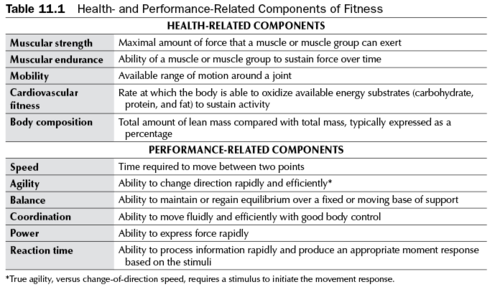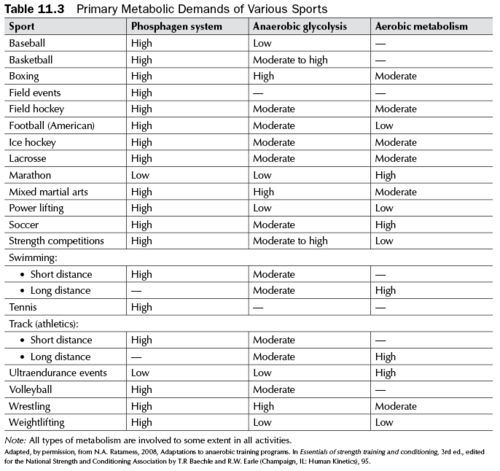Test Selection
When determining what tests to select, the first thing to consider is the desired outcome of the training program. You can select from literally thousands of tests to measure health, fitness, and performance! But the feasibility of many of these tests, in terms of resources, time, and experience in performing and conducting them, is a key limiting factor. In chapter 12 we provide numerous examples of tests that measure both fitness and performance, are relatively easy to perform, and require minimal time, experience, and equipment to do well. Our aim is to present options to suit the goals of most readers, but we cannot possibly cover every possible test that might be applicable to a given sport or activity. Therefore, in this chapter we discuss in broad terms some of the factors to consider when selecting a test and ways to improve the results that you obtain from these measures.
Health- and Performance-Related Components of Fitness
Table 11.1 includes a list of the health- and performance-related components of fitness. Although the variables are often split into these two categories, understanding the distinction can be difficult, probably because most of these components are interrelated to some extent. For example, strength, speed, power, and mobility are all underpinning characteristics of agility. Therefore, a person who is deficient in one of these areas might also be hindered in terms of agility.
Health Assessment
Health is the foundation of fitness and performance. Therefore, to attain optimal levels of fitness and performance, good health is essential. For this reason, some basic health assessments should be performed before testing or beginning an exercise program. At minimum, a basic health-risk appraisal should be performed before you begin an exercise program. The Physical Activity Readiness Questionnaire (PAR-Q) is a good tool for people who are participating in a self-guided exercise program (Spivey 2010). This questionnaire has been recognized as a good minimal prescreening for low- to moderate-level activity. If you answer yes to any of the questions listed in the PAR-Q, a more comprehensive evaluation by a qualified medical professional is warranted. To complete the questions listed in the PAR-Q, visit www.csep.ca/cmfiles/publications/parq/par-q.pdf.
Needs or Goals Analysis
When selecting tests, the best approach is to begin with the end in mind. In other words, what are the desired outcomes of your training program and how can you make certain that you have attained these goals? Generally, this process begins with performing a needs, or goals, analysis. Within this analysis, you should consider several factors, including the physiological, metabolic, and biomechanical demands of the activity in which you are seeking to make improvements. The following are a few questions that you should address before selecting which assessments to perform.
-
What are the main muscles or muscle groups needed to perform the target activity, and what actions are they performing?
Are these muscles primarily used for strength and power movements in this activity (Type II fast-twitch muscle fibers) or endurance (Type I slow-twitch muscle fibers)? For instance, distance running uses predominately Type I muscle fibers, whereas sprinting uses predominately Type II muscle fibers. For this reason, strength and power tests would likely be better predictors of sprint performance than muscular endurance tests. Similarly, tests that assess muscular endurance of the trunk would likely be better predictors of potential injury for endurance athletes who must attempt to stabilize these muscles against gravity for long periods, especially under fatigue when mechanics may be compromised.
Generally, muscles produce force (muscle fibers shorten to accelerate), reduce force (muscle fibers elongate to decelerate the body or limbs), and stabilize the body (tension is developed in the muscle fibers, but no real change in the length of the fiber is realized).
-
What range of motion and what type and duration of power are necessary for the activity?
Most endurance activities, such as distance running, require smaller ranges of motion and require more sustained power over long distances for extended periods. In contrast, most explosive activities, such as sprinting and jumping, typically require greater ranges of motion and rapid force and power development over shorter distances.
Therefore, although ROM is important for both groups of athletes to improve performance and reduce injury risk, athletes who perform explosive actions are likely to have greater dynamic ROM at certain joints because they are required to move the body through these ranges more frequently. These athletes would benefit from this type of testing and training.
-
What energy systems (
phosphagen
, glycolytic, aerobic) are used and in what amounts?
During various activities, different energy systems are called on to help provide energy. The ATP–PCr system is essential for exercises that require short bursts of explosive activity lasting less than 15 seconds. When the fuel sources for this energy system have been exhausted, the glycolytic energy system can be used to help supply energy to the body from stored carbohydrate (glycogen). As these energy supplies become depleted, generally within two to three minutes of moderate- to high-intensity activity, the body begins to rely more on the aerobic, or oxidative, energy system to provide energy. This system becomes more active in the production of energy when energy needs to be sustained for greater than two or three minutes. Consequently, the intensity of the exercise is lower than it is during anaerobic activity.
But a tradeoff between intensity and time is at play here, meaning that the longer the duration of the activity is, the lower the intensity must be to sustain the activity. Thus, the primary energy system called on to provide energy is based largely on the intensity and duration of the activity. Table 11.2 shows the relationship between intensity and duration for the energy systems. Table 11.3 shows the approximate energy contribution by energy system for each activity.
-
What are common injuries, or injury sites, related to this activity?
With most activities, injury is always a risk. For instance, during long runs the muscles of the trunk may become fatigued and make it difficult to maintain good posture. Therefore, distance runners may be prone to lower back issues. Good muscular endurance in this area may help alleviate some of the postural changes caused by fatigue in this population. Thus, improving muscular endurance of the trunk would be of interest. Based on this notion, the front and side plank tests may be useful for measuring improvements in this area.
Testing may also help us identify potential injury issues to address. For example, Emma is a high school volleyball athlete who successfully passed a squat assessment, but she was unable to perform the box step-off without her knees collapsing inward (valgus collapse). Because volleyball requires repeated jumps within a match, the repetitive stress of her landing in this irregular positon over time could result in injury. Therefore, jumping activities were contraindicated for Emma in her training program until she built up the requisite strength to absorb the landing with proper technique.
This area of assessment can be tricky and may require a bit more experience and expertise to administer. Therefore, seeking the assistance of a certified strength and conditioning specialist with training in this area may be beneficial. Chapter 12 includes a few basic movement screenings that help identify poor movement patterns that could lead to injury or warrant referral to a medical professional.
Validity and Reliability
Validity and reliability are major concepts related to testing. Validity is the ability of a test to produce an accurate measurement of a specific outcome or attribute, and a reliable test is one that is repeatable. For a test to be valid, it must be reliable, but a test can be reliable without being valid. For example, if a person selected a vertical jump assessment to measure lower-body strength, the test would be reliable as long as the same protocols and procedures were followed for each trial. But the test may not be valid for measuring strength because this test is primarily used for measuring power. These two variables are related, because people with stronger lower bodies generally tend to jump higher, but a more valid test of lower body strength would be a 1–3RM squat. Another example would be the push-up versus the 1.5 mile (2.4 km) run to test endurance. Both are endurance tests, but the run measures endurance of the cardiovascular system using primarily the lower body, whereas the push-up test measures upper-body muscular endurance. Both measure endurance, but they test different body regions and different systems (cardiovascular versus muscular endurance).






